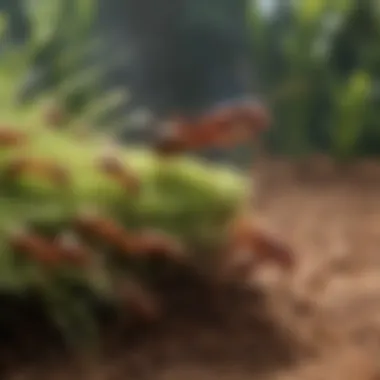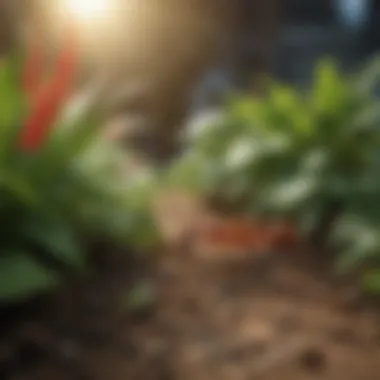Scotts Fertilizer with Fire Ant Killer: A Comprehensive Review


Intro
Understanding pest management and soil health is critical for both hobbyist gardeners and professional farmers. One product that combines these two elements is Scotts fertilizer infused with fire ant killer. This unique formulation does not merely support plant growth; it also tackles the troublesome issue of fire ant infestations. This article aims to dissect this dual functionality, considering its effectiveness, application methods, and potential impacts on plant health. By elucidating its components and exploring case studies, we hope to inform readers about making knowledgeable decisions regarding pest management and fertilization practices in their gardens or fields.
Scotts fertilizer with fire ant killer has garnered attention for its integrated approach to agricultural health. It symbolizes a step forward in combining the need for pest control with soil enrichment. The discussion will unravel around key concepts, practical applications, and recent trends associated with this product.
Preamble to Scotts Fertilizer with Fire Ant Killer
Scotts Fertilizer with Fire Ant Killer represents a unique convergence of fertilization and pest management. Understanding the significance of this dual-purpose product is essential for both home garden enthusiasts and professional agronomists. It provides a viable solution to a common problem encountered in gardening: the invasion of fire ants, which can harm both plants and soil health. This article serves as a thorough exploration of the product's formulation, application methods, and effectiveness against fire ants, allowing readers to not only enhance plant vitality but also manage pest issues effectively.
Understanding the Product
Scotts Fertilizer with Fire Ant Killer combines traditional nutrients that plants need to thrive with targeted insecticides effective against fire ants. This integration is intended to simplify the gardening process, offering a single product that serves two essential functions. The formulation includes slow-release nitrogen and other essential nutrients that promote healthy growth while also containing active ingredients that control fire ant populations. This innovative approach reduces the time and effort required for separate fertilizer and pest control applications.
The Need for Pest Control in Gardening
Pest control is a significant concern for anyone involved in gardening, whether for ornamental purposes or food production. Fire ants, in particular, are notorious for disrupting local ecosystems. They can damage plant roots and affect soil health. Their presence not only reduces yields but can also make gardening less enjoyable due to the risk of painful stings. Therefore, an effective pest control strategy is crucial. Using a product like Scotts Fertilizer with Fire Ant Killer addresses this need, ensuring that gardeners can maintain a productive and safe environment for their plants. By integrating this into a routine, gardeners can effectively manage fire ants without sacrificing the health of their plants.
Chemical Composition and Mechanism of Action
Understanding the chemical composition and mechanism of action is vital when evaluating the efficacy of Scotts Fertilizer with Fire Ant Killer. Both components must work in harmony to ensure effective pest management while simultaneously enhancing soil fertility. The formulation's interaction between nutrients and insecticides plays a crucial role in achieving optimal results in gardening. By dissecting these elements, we gain insight into how this product functions and the implications it has for users.
Active Ingredients in Fire Ant Killer
The active ingredients in the fire ant killer component of Scotts products often include pyrethroids and imidacloprid. Pyrethroids are synthetic chemicals mimicking natural insecticides derived from chrysanthemum flowers. They disrupt the nervous system of fire ants upon contact, paralyzing and ultimately killing them. On the other hand, imidacloprid, a neonicotinoid, affects the neurotransmitters in the ants, rendering them unable to communicate with each other, which leads to colony collapse.
Both elements work synergistically. Pyrethroids provide immediate knockdown effects, while imidacloprid offers longer-lasting control by targeting the nest. Understanding these active ingredients prepares users to use the product effectively, while also recognizing the proper application protocols for pest management.
Nutrient Components of Scotts Fertilizer
Scotts Fertilizer is not just a means to kill fire ants; it is also formulated to enrich the soil. The nutrient components generally include nitrogen, phosphorus, and potassium, often referred to as N-P-K ratios. Nitrogen stimulates vigorous plant growth and lusher foliage. Phosphorus promotes root development and flowering, while potassium enhances overall plant health, resilience, and enhances drought resistance.
These nutrients not only support plants in becoming robust but also assist in recovery after pest attacks. It is essential to balance these nutrients with pest control measures, as over-fertilization may lead to increased pest activity, inadvertently exacerbating the problem for gardeners.
How the Formulation Targets Fire Ants
The targeted approach of Scotts Fertilizer with Fire Ant Killer relies on its specific combination of active ingredients and application methods. The formulation is designed to absorb into the fire ant's body through both ingestion and contact. When ants consume the bait, the imidacloprid disrupts their communication while pyrethroids rapidly eliminate individuals. This two-pronged strategy not only reduces populations quickly but also mitigates future infestations as the remaining colony members become incapacitated.


Crucially, the effectiveness hinges on correct application timing and technique. Following product guidelines helps ensure maximum contact with the ants and prevents collateral damage to beneficial insects present in the garden. Understanding the formulation's target and deployment allows users to achieve comprehensive pest control without compromising plant health.
Understanding the interaction between chemical composition and efficacy will help shape future gardening strategies.
Application Techniques and Best Practices
Understanding how to apply Scotts fertilizer with fire ant killer effectively is essential for both pest control and the promotion of plant health. Proper application ensures optimal coverage, leading to a reduction in fire ant populations while simultaneously nourishing the soil. This dual purpose not only benefits the garden but also enhances productivity for growers.
Step-by-Step Application Guide
Applying Scotts fertilizer with fire ant killer can seem daunting, but breaking it down into manageable steps can help simplify the process:
- Preparation: Begin by reading the label carefully. Understand the specific recommendations regarding dosage and timing.
- Choosing Application Equipment: Decide if you will use a spreader or apply it by hand. For larger areas, using a spreader will provide even coverage.
- Extent of Area: Map out the area that requires treatment. This helps to visualize the task and ensures thorough application.
- Initial Conditions: Ensure the soil is moist but not saturated. This will help the fertilizer to mix with the soil effectively.
- Application: For granular form, spread it evenly across the designated area. Avoid clumping in one place. For liquid form, follow the dilution ratios recommended on the label.
- Follow-Up Watering: Lightly watering the area after application can help the fertilizer penetrate into the soil and activate the fire ant killing properties. As a rule, avoid heavy rain within 24 hours of application.
Timing Applications for Maximum Efficacy
Timing is crucial for the effectiveness of Scotts fertilizer with fire ant killer. Knowledge about fire ant behavior can aid in determining the best application times:
- Early Spring: Applying in early spring, when fire ants are actively foraging, can yield better results.
- Evening Applications: Fire ants tend to be more active in the cooler parts of the day, making evening applications particularly effective.
- Avoiding Rainy Days: Ensure that there is no rain predicted 24 hours before and after applying. Rain can wash away the product, greatly reducing its effectiveness.
- Seasonal Timing: Make note of the life cycles of fire ants in your area. Understanding their breeding patterns can help strategize applications.
Safety Precautions When Using the Product
Safety cannot be overlooked when applying chemical products, including Scotts fertilizer with fire ant killer. Here are some important precautions to consider:
- Personal Protection: Wear gloves and a mask to prevent direct contact with skin and avoid inhaling any dust.
- Keep Pets and Children Away: Ensure that the area is clear of pets and children during and after application until it is safe to return.
- Application History: Keep records of when and where you applied the product for future reference.
- Follow Instructions: Adhere strictly to the instructions provided on the label. This will ensure not only safety but also effectiveness in application.
"Understanding the correct application techniques is fundamental to achieving optimal results with Scotts fertilizer and fire ant killer."
With these best practices in mind, the use of Scotts fertilizer with fire ant killer can be both effective and safe, leading to healthier plants and a more manageable fire ant problem.
Effectiveness Against Fire Ant Populations
Understanding the effectiveness of Scotts Fertilizer with Fire Ant Killer is crucial for anyone tackling the pervasive issue of fire ants in gardens and landscapes. Fire ants not only disrupt the aesthetics of an area but also pose risks to both plant health and human comfort. An effective product like Scotts can help mitigate these problems, making pest control more accessible and efficient for various users, from home gardeners to professional landscapers. This section examines field studies and user experiences to capture a comprehensive view of how this product performs.
Field Studies and Research Observations
Field studies provide important insights into the performance of Scotts Fertilizer with Fire Ant Killer. Various research conducted in different environments has shown that this product significantly reduces fire ant populations. For instance, studies have demonstrated a measurable decline in ant activity following application, confirming its efficacy.
Research indicates that the active ingredients in the formulation target the fire ants effectively, leading to quick results. Observations from multiple trials have noted a substantial decrease in not just the number of visible ants, but also their nests.


In agricultural settings, where fire ants can damage crops and harm livestock, the results are particularly impactful. Farmers reported a notable reduction in ant-related issues, which in turn supports healthier crop yields. This is a critical aspect when considering pest management strategies.
"Effective pest control is essential for sustainable agriculture. Field data indicates that Scotts product provides both pest management and plant health benefits."
User Experiences and Testimonials
User experiences enrich the understanding of Scotts Fertilizer with Fire Ant Killer's effectiveness. Many users have shared their accounts emphasizing its dual action—fertilizer and pest deterrent. Gardeners often report not only seeing reduced fire ant numbers but also witnessing improved plant growth as a result.
Testimonials highlight the ease of use. Users appreciate the straightforward application techniques that allow for quick treatment of affected areas. Additionally, the product's visible results contribute to user satisfaction. Some users have shared anecdotes of previously infested areas being cleared of fire ants within days of application.
However, it is important to note that results can vary based on environmental conditions and adherence to application guidelines. Users who follow best practices often see the best outcomes. Integrating feedback from the community provides valuable insights into its practicality and effectiveness.
Environmental Considerations
The discussion on Scotts Fertilizer with Fire Ant Killer cannot be complete without evaluating its environmental implications. The integration of chemical pest control with fertilizer offers both potential benefits and risks to the ecosystem. Understanding these factors is vital for gardeners and farmers aiming for sustainable practices while managing pests effectively.
Impact on Non-Target Species
One of the primary concerns regarding chemical pesticides is their effect on non-target species. Fire ant control measures can unintentionally harm beneficial insects, such as pollinators and predatory species, which are essential for maintaining ecological balance.
Scotts formulation is developed with precision, targeting specifically fire ants while minimizing harm to other insects. However, even selective pesticides can pose risks. Users should be cautious about application timing and local biodiversity. For instance, applying the product when beneficial insects are most active could result in unintended casualties. It's crucial to monitor local populations and adjust practices accordingly to ensure that essential species are preserved.
Key Considerations:
- Timing: Apply during times when non-target species are least active.
- Location: Assess the surrounding flora and fauna to determine vulnerabilities.
- Application Methods: Using targeted application techniques can greatly reduce the risk to non-target insects.
"A careful application strategy can substantially limit adverse effects on the surrounding ecosystem."
Soil Health and Microbial Activity
The relationship between chemical fertilizers and soil health is complex. While Scotts Fertilizer with Fire Ant Killer promotes plant growth, it is important to consider its influence on soil microbial activity. Soils rich in microbial life are crucial for nutrient delivery and organic matter decomposition, which in turn support robust plant health.
The introduction of synthetic chemicals can disrupt microbial communities. Some studies indicate that certain active ingredients in pesticides can negatively affect microbial diversity and function.
To mitigate potential adverse effects on soil health, consider the following:
- Integrate Organic Matter: Adding compost or organic fertilizers alongside chemical products can help enhance microbial populations.
- Monitor Soil Health: Regular soil testing can provide insights into microbial activity and overall soil health, allowing for adjustments in application protocols.
- Rotate Treatments: Using a mix of chemical and organic products can balance nutrient needs with soil health, minimizing long-term damage.


Integrating Fertilizer and Pest Management Strategies
The integration of fertilizer application with pest management strategies is vital in enhancing both plant health and pest control efficiency. This holistic approach aligns nutritional requirements with effective pest solutions, ultimately contributing to sustainable gardening and farming practices. When utilizing Scotts fertilizer with fire ant killer, combining these practices not only maximizes effectiveness but also minimizes environmental impact. Understanding how to effectively integrate these elements can lead to healthier plants and a more balanced ecosystem in the garden.
Companion Planting and Integrated Pest Management
Companion planting serves as a fundamental concept within integrated pest management (IPM). The practice involves strategically placing plant species in proximity to one another to enhance growth, deter pests, and attract beneficial insects. For instance, planting marigolds alongside vegetable crops creates a natural deterrent for various pests, including fire ants. This tactic works synergistically with chemical solutions like Scotts fertilizer combined with fire ant killer.
Here are several benefits of companion planting:
- Pest Deterrence: Certain plants repel pests naturally, reducing the reliance on chemical interventions.
- Biodiversity Enhancement: Increasing plant diversity can foster a more resilient garden ecosystem and weaken pest populations.
- Nutritional Synergy: Plants can support each other's growth through nutrient exchange, leading to overall improved health.
Moreover, gardeners can strategically apply Scotts fertilizer where companion plants are located. This ensures that beneficial species thrive, countering fire ant infestations simultaneously. When combined with fertilizer treatments, companion planting becomes a powerful tool in the arsenal against pests.
Using Organic Alternatives Alongside Chemical Products
The discussion of pest management must also incorporate the consideration of organic alternatives. While Scotts fertilizer with fire ant killer provides an effective solution, gardeners and farmers may find that integrating organic methods enhances sustainability. Organic options often include neem oil, diatomaceous earth, or insecticidal soaps. These products can offer effective pest control without the potential negative impacts associated with chemical fertilizers.
Using organic alternatives presents several key advantages:
- Reduced Chemical Exposure: Implementing organic methods lowers the risk of chemical residues in soil and on plants, contributing to food safety.
- Enhanced Soil Health: Organic alternatives often support soil microbes and nutrients that chemical interventions can disrupt.
- Regulatory Compliance: For conventional farms transitioning to organic practices, utilizing organic pest control solutions facilitates adherence to regulatory standards.
Integrating these organic methods with the Scotts fertilizer application involves careful planning. Gardeners should regularly assess pest populations, alternating between chemical and organic methods as necessary. This strategy not only provides enduring pest control solutions but also fosters resilient plant growth, thereby leading to a more sustainable gardening practice.
The End and Future Perspectives
The exploration of Scotts fertilizer with fire ant killer highlights its notable role in modern gardening and agricultural practices. This section ties together various aspects of the product's efficacy, underscoring its ability to both fertilize soil and manage unwanted fire ant populations. It is clear that the dual-purpose functionality of this product can significantly benefit gardeners and farmers alike, providing a convenient solution for pest control while promoting healthy plant growth.
In understanding the topic, it is important to consider the complex interplay between pest management and soil fertility. Increasing numbers of gardeners are recognizing that pests are not just a nuisance but can also impact crop yields and the overall health of their gardens. Thus, the combination of Scotts fertilizer and fire ant killer serves as a comprehensive approach to managing these issues effectively.
Summary of Key Findings
Several key points emerge from this article, reinforcing the product's value:
- Dual Functionality: Scotts fertilizer with fire ant killer provides essential nutrients for plant growth while targeting damaging pests.
- Proven Effectiveness: Field studies support its effectiveness against fire ants, showing a decline in their populations post-application.
- Environmental Considerations: Awareness of the ecological impacts, including effects on non-target species, is necessary for responsible usage.
- User Testimonials: Experiences shared by users highlight satisfaction, efficacy, and renewed plant vigor after application.
Combining these findings suggests that users can achieve a healthier garden environment while minimizing pest infestations.
Potential Innovations in Pest Control and Fertilization
The future of pest management and fertilization may very well include further innovations. Ongoing research in the realm of agronomy and botany is expected to yield new solutions tailored for specific pest challenges. Some potential avenues of development include:
- Biological Control Methods: Integrating beneficial microbes or insects that prey on fire ants could reduce dependency on chemical treatments.
- Advanced Formulations: Developing time-released fertilizers that also incorporate pest mitigation compounds, allowing for longer-lasting effects.
- Precision Agriculture: Utilizing technology to tailor applications to soil health and pest populations could create a more efficient approach.
- Sustainable Practices: Increasing emphasis on organic and eco-friendly strategies could lead to the formulation of similar alternatives devoid of harsh chemicals.
These innovations may revolutionize the way gardeners and farmers approach pest management, making efforts more sustainable while addressing ecological concerns head-on. As research continues to evolve, the integration of novel practices alongside well-established products like Scotts fertilizer will likely enhance overall agricultural resilience.















